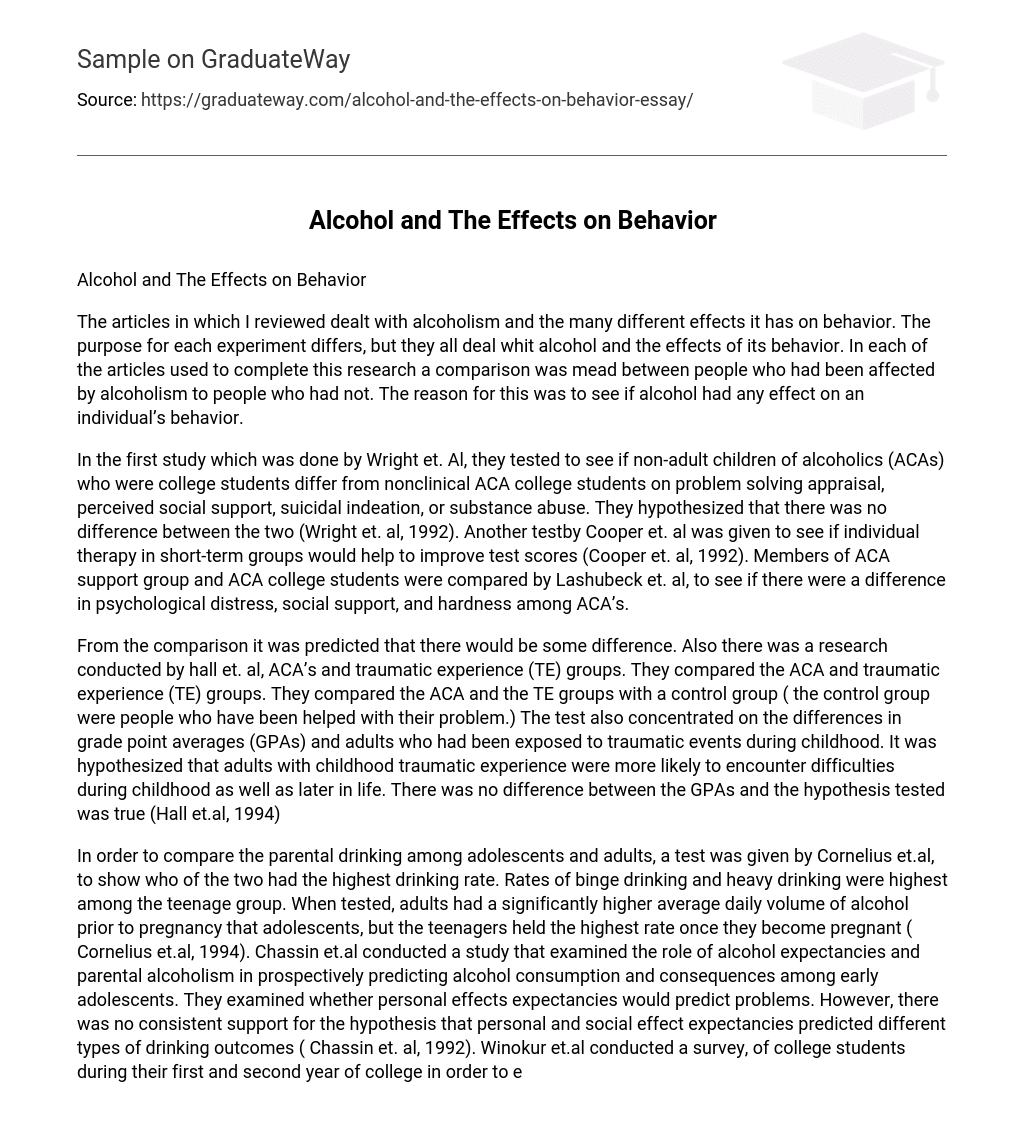The reviewed articles all center around alcoholism and its effects on behavior. Despite having different objectives, they each study the impact of alcohol on behavior. Each article conducted a comparison between individuals affected by alcoholism and those who were not, with the goal of assessing the influence of alcohol on behavior.
The first study conducted by Wright et. Al aimed to compare non-adult children of alcoholics (ACAs) who were college students with nonclinical ACA college students in terms of problem solving appraisal, perceived social support, suicidal indeation, and substance abuse. They proposed that there would be no difference between the two (Wright et. al, 1992). Another examination conducted by Cooper et. al evaluated the impact of individual therapy in short-term groups on test scores (Cooper et. al, 1992). Lashubeck et. al compared members of the ACA support group with ACA college students to determine if there were variations in psychological distress, social support, and hardness among ACAs.
According to the comparison made, variation was expected. Additionally, Hall et. al conducted a study comparing ACA’s and traumatic experience (TE) groups to a control group who received assistance with their issues. The research analyzed differences in grade point averages (GPAs) among adults who had undergone childhood traumatic events. The hypothesis suggested that adults who had experienced childhood trauma would encounter challenges both during their childhood and later in life. However, the GPAs showed no disparities, thus confirming the validity of the tested hypothesis (Hall et.al, 1994).
Cornelius et.al (1994) conducted a test comparing parental drinking rates among adolescents and adults. They discovered that teenagers had the highest rates of binge drinking and heavy drinking. However, prior to pregnancy, adults consumed significantly more alcohol on a daily basis compared to adolescents. Interestingly, once pregnant, teenagers had the highest drinking rate.
In another study by Chassin et.al (1992), they examined how alcohol expectancies and parental alcoholism predicted alcohol consumption and consequences in early adolescents. They investigated whether personal effects expectancies would predict problems but found no consistent support for this hypothesis. It was not observed that personal and social effect expectancies predicted different types of drinking outcomes.
Winokur et.al also studied the development of alcohol use behavior in college among first and second-year students. The survey results indicated that every student who used alcohol during the first year continued to do so during the second year. Additionally, Wschsler et al.(1991) hypothesized that students who engaged in heavy drinking in high school were more likely to be binge drinkers in college, which was proven true.
In general, this text emphasizes that excessive alcohol consumption is not commonly acquired behavior during college.The importance of college programs that focus on identifying and intervening early, rather than just preventing alcohol use, is emphasized.
The articles analyzed employed different tests and surveys to either support or refute their hypothesis. With the exception of Cornelius et al. and Winokur et al., all hypotheses were supportive. The experiments involved both ACAs and college students as subjects. From the information presented in these articles, it can be inferred that alcohol does impact individuals.
The purpose of the survey is to investigate if there is a distinct influence on students’ mathematics and grammar abilities due to a genetic predisposition towards alcohol. The hypothesis proposes that students from families with a history of alcoholism will have diminished skills after consuming one glass of alcohol.
Subject
A total of 12 students participated in the experiment, with six students coming from families with alcoholic parents (dependent variable) and six students not coming from such families (independent variable). All students were required to take a Breath Alizer test and had to register a reading no higher than 0.01 on the device.
Materials
All students were given the following materials: a pretest in mathematics and grammar, a glass of alcohol, a posttest in mathematics and grammar, and a Breath Alizer test. The mathematics posttest will cover the four basic arithmetic operations (adding, subtraction, division, and multiplication) to ensure accurate measurement. The grammar posttest will include a sentence completion test where the verb in each sentence is omitted and students must select the correct verb and its correct tense (present or past).
Procedure
All students were individually interviewed in their dorms and placed in undisclosed groups for the investigation. Consent was obtained from all students to participate. Each student was then provided with a glass of alcohol and instructed to drink until reaching a Breathalyzer reading of 0.01. Following this, a mathematics and grammar test was administered. A second test was scheduled for the following week, accompanied by another glass of alcohol and a Breathalyzer test.
Result
The study utilized the T-test to analyze its findings, with a specific focus on determining whether a genetic predisposition towards alcohol had a greater impact on mathematical abilities. Individuals who had a genetic inclination towards alcohol achieved an average score of 95, while those without alcoholic parents obtained an average score of 91.67. The data from the independent T test showed a T-score of -.21 (SD= 8783.3) and a standard error of 18.74, with degrees of freedom (DF) equal to 10. Despite setting the significance level (P*) at 0.05, the results did not reach statistical significance.
The number of students in each group was six. The mean score for grammar was 80 for participants who did not come from parents of alcoholic parents. The data from the Independent T test showed T=0, with a standard error of 16.1 (SD= 6466.66), DF=10, and P*.05. However, the results were not found to be significant.
Discussion
The hypothesis that the impact of one glass of alcohol is diminished in students with alcoholic parents was not confirmed. The study encompassed 12 participants, consisting of six individuals with alcoholic parents and six individuals without alcoholic parents.





